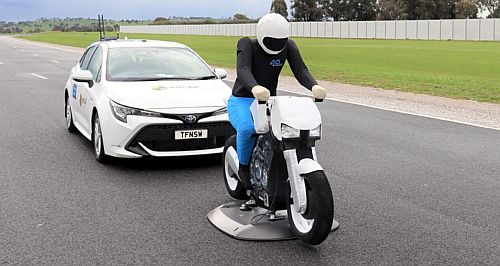Make / Model Search
News - General News - SafetyANCAP unveils 2030 test protocol pathwayNew criteria: Two wheelers and commercial vehicles will come under the ANCAP microscope in coming years. Safety focus on new tech, motorbikes, commercial vehicles in support of ‘Vision Zero’14 Nov 2022 ANCAP (Australasian New Car Assessment Program), together with its European counterpart, Euro NCAP, are focused on staying current with rapidly changing new safety technology when formulating crash test scoring protocols and methodology.
The two interwoven road safety organisations have released their “pathway” to 2030 by containing details about a range of new safety tests that will be incorporated into existing star ratings.
ANCAP says this change will take effect from 2026, and will be subject to a three-year protocol update cycle rather than the previous two years.
Included are passive safety tests that give greater focus to gender equality and the ageing population. To this end, a new crash-test dummy called THOR 5F will be introduced, representing a fifth-percentile female (THOR stands for Test device for Human Occupant Restraint).
According to ANCAP the THOR 5F is “anthropomorphically designed off a small adult female and offers improved biofidelity and injury measurement capability when compared to the existing fifth-percentile female dummy”.
Evaluation of more vehicle types, including testing of the active safety capability on motorcycles and motor scooters ('powered two wheelers') as well as heavy goods vehicles are also in the pipeline.
Revised active safety tests that more closely simulate real road environments and examine human-machine interface (HMI) design will also be implemented, along with testing and assessment of assisted and automated driving systems.
The changes will include testing and assessment of V2V (vehicle to vehicle), V2I (vehicle to infrastructure) and V2X (vehicle to everything) communication.
Additionally, new rules will be put in place for fire risk and thermal runaway in electric vehicles, driver impairment and cognitive distraction along with cyber security and over-the-air (OTA) updates.
While autonomous driving is potentially still a way off, ANCAP and Euro NCAP are planning to introduce testing procedures for assisted and automated driving.
The focus will be on four key areas of ANCAP assessment that have been in place since 2018 – all of which will be adjusted to reflect the four distinct phases of a potential crash event: safe driving; crash avoidance; crash protection and post-crash safety.
ANCAP chief executive Carla Hoorweg described the announcement as “a milestone day for vehicle safety”.
"From ANCAP's very beginning in the 1990s, it was our aim to encourage improvements in vehicle safety, and that keen pursuit continues," she said.
"The release of the 2030 future view establishes the key testing and assessment focus areas for the industry – both for our existing automotive industry stakeholders, and for a new cohort of industry stakeholders that have not previously engaged in the NCAP process.
"For our existing star rating program, the evolutionary shift in our assessment pillars acknowledges the important role assisted and automated technologies will play in reducing road-related fatalities and serious injuries among light passenger vehicles.
"The move to explore assessment of medium and heavy trucks is a notable shift and seeks to address the over-representation of these vehicles in road fatalities and serious injuries."
Euro NCAP secretary general Michiel van Ratingen added: "In support of Vision Zero Vision Zero (A principle that no one should be killed or seriously injured using our road networks), ANCAP and Euro NCAP's non-regulatory influence continues to hold the potential for further improvements in vehicle safety throughout the next decade.
“By developing timely voluntary standards for advanced safety technology, we can act as a catalyst for accelerating uptake and promoting best practice – not just for passenger cars, but also in the commercial vehicle fleet."
ANCAP attributes significant safety improvements that have entered the Australian, New Zealand and European vehicle markets over the past three decades to the two organisation’s continuous drive to address the on road vehicle-safety-related challenges among the light vehicle fleet.
The two safety organisations are now working through this ‘future plan’ acknowledging the changing mobility landscape and the role the organisations can play in further improving vehicle safety over the coming decade.
"Both the Australian and New Zealand governments are targeting zero road fatalities and serious injuries by 2050. ANCAP will play a key role in ensuring today's vehicles are equipped to deliver on this objective,”said Ms Hoorweg.
“The automotive industry continues to innovate and is already delivering safety systems that go beyond current regulatory requirements.
“By setting timely voluntary standards for advanced safety features and technologies, ANCAP continues to be the catalyst for accelerating uptake and promoting best practice across the passenger and commercial vehicle fleet."  Read more |
Click to shareGeneral News articlesResearch General News Motor industry news |















Facebook Twitter Instagram